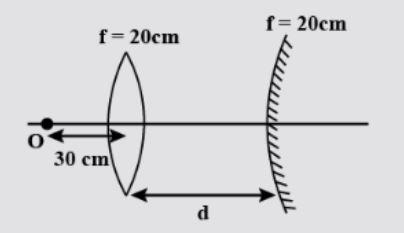
A convex lens and convex mirror are placed co axially and separated by distance d. The focal length of both is \[20\,\,cm\] each. A point object is placed at a distance \[30\,\,cm\] from the lens as shown. Then the value of d so that image on the object itself is

A) $10\,\,cm$
B) \[60\,\,cm\]
C) \[30\,\,cm\]
D) \[20\,\,cm\]
Answer
216.3k+ views
Hint:- The above problem can be solved using the formula derived from the object image and focal distance relationship formulas of the convex lens and the convex mirror of the same focal length. The formula for the focal length of the lens and the mirror is used.
Useful formula:
The distance of the value $d$;
\[\dfrac{1}{d} = \dfrac{1}{f}\]
Where, the $d$ is the distance between the convex lens and convex mirror, $f$ is the focal length of the convex mirror.
Complete step by step solution:
The data given in the problem is;
Focal length of the convex lens is, ${f_1} = 20\,\,cm$.
Focal length of the convex mirror is, ${f_2} = 20\,\,cm$
Distance of the image placed from the image is, ${u_1} = 30\,\,cm$
At convex lens;
$\dfrac{1}{{{f_1}}} = \dfrac{1}{{{v_1}}} + \dfrac{1}{{{u_1}}}$
Substituting the value of focal length and the object distance from the lens
$
\dfrac{1}{{20}} = \dfrac{1}{{{d_i}}} + \dfrac{1}{{30}} \\
\dfrac{1}{{20}} - \dfrac{1}{{30}} = \dfrac{1}{{{d_i}}} \\
$
Where, ${d_i}$ denotes the distance of the image at convex lens.
\[\dfrac{1}{{{d_i}}} = \dfrac{1}{{60}}\]
At convex mirror:
$\dfrac{1}{{{f_2}}} = \dfrac{1}{{{d_i}}} + \dfrac{1}{{{u_o}}}$
Substitutes the values of the focal length and the image distance;
$
\dfrac{1}{{20}} = \dfrac{1}{{60}} + \dfrac{1}{{{d_o}}} \\
\dfrac{1}{{20}} - \dfrac{1}{{60}} = \dfrac{1}{{{d_o}}} \\
$
Where, ${d_o}$ denotes the distance of the object at convex mirror.
\[\dfrac{1}{{{d_o}}} = \dfrac{1}{{30}}\]
The distance of the value $d$;
\[\dfrac{1}{d} = \dfrac{1}{f}\]
That is
\[
\dfrac{1}{d} = \dfrac{1}{f} = \dfrac{1}{{{d_i}}} + \dfrac{1}{{{d_o}}} \\
\dfrac{1}{d} = \dfrac{1}{{60}} + \dfrac{1}{{30}} \\
\dfrac{1}{d} = \dfrac{{90}}{{1800}} \\
d = 20\,\,cm \\
\]
Therefore, the value of the $d$ is 20 cm.
Hence the option (D), \[d = 20\,\,cm\] is the correct answer.
Note: Image distance denotes that when the image is created then the distance between pole and image is known image distance. Focal length is the interval between pole and the principal focus of the mirror.
Useful formula:
The distance of the value $d$;
\[\dfrac{1}{d} = \dfrac{1}{f}\]
Where, the $d$ is the distance between the convex lens and convex mirror, $f$ is the focal length of the convex mirror.
Complete step by step solution:
The data given in the problem is;
Focal length of the convex lens is, ${f_1} = 20\,\,cm$.
Focal length of the convex mirror is, ${f_2} = 20\,\,cm$
Distance of the image placed from the image is, ${u_1} = 30\,\,cm$
At convex lens;
$\dfrac{1}{{{f_1}}} = \dfrac{1}{{{v_1}}} + \dfrac{1}{{{u_1}}}$
Substituting the value of focal length and the object distance from the lens
$
\dfrac{1}{{20}} = \dfrac{1}{{{d_i}}} + \dfrac{1}{{30}} \\
\dfrac{1}{{20}} - \dfrac{1}{{30}} = \dfrac{1}{{{d_i}}} \\
$
Where, ${d_i}$ denotes the distance of the image at convex lens.
\[\dfrac{1}{{{d_i}}} = \dfrac{1}{{60}}\]
At convex mirror:
$\dfrac{1}{{{f_2}}} = \dfrac{1}{{{d_i}}} + \dfrac{1}{{{u_o}}}$
Substitutes the values of the focal length and the image distance;
$
\dfrac{1}{{20}} = \dfrac{1}{{60}} + \dfrac{1}{{{d_o}}} \\
\dfrac{1}{{20}} - \dfrac{1}{{60}} = \dfrac{1}{{{d_o}}} \\
$
Where, ${d_o}$ denotes the distance of the object at convex mirror.
\[\dfrac{1}{{{d_o}}} = \dfrac{1}{{30}}\]
The distance of the value $d$;
\[\dfrac{1}{d} = \dfrac{1}{f}\]
That is
\[
\dfrac{1}{d} = \dfrac{1}{f} = \dfrac{1}{{{d_i}}} + \dfrac{1}{{{d_o}}} \\
\dfrac{1}{d} = \dfrac{1}{{60}} + \dfrac{1}{{30}} \\
\dfrac{1}{d} = \dfrac{{90}}{{1800}} \\
d = 20\,\,cm \\
\]
Therefore, the value of the $d$ is 20 cm.
Hence the option (D), \[d = 20\,\,cm\] is the correct answer.
Note: Image distance denotes that when the image is created then the distance between pole and image is known image distance. Focal length is the interval between pole and the principal focus of the mirror.
Recently Updated Pages
Wheatstone Bridge Explained: Working, Formula & Uses

Young’s Double Slit Experiment Derivation Explained

JEE Atomic Structure and Chemical Bonding important Concepts and Tips

JEE Amino Acids and Peptides Important Concepts and Tips for Exam Preparation

Electricity and Magnetism Explained: Key Concepts & Applications

Chemical Properties of Hydrogen - Important Concepts for JEE Exam Preparation

Trending doubts
JEE Main 2026: Application Form Open, Exam Dates, Syllabus, Eligibility & Question Papers

Derivation of Equation of Trajectory Explained for Students

Hybridisation in Chemistry – Concept, Types & Applications

Understanding the Angle of Deviation in a Prism

Understanding Collisions: Types and Examples for Students

How to Convert a Galvanometer into an Ammeter or Voltmeter

Other Pages
JEE Advanced Marks vs Ranks 2025: Understanding Category-wise Qualifying Marks and Previous Year Cut-offs

Ideal and Non-Ideal Solutions Explained for Class 12 Chemistry

Degree of Dissociation: Meaning, Formula, Calculation & Uses

Understanding Electromagnetic Waves and Their Importance

Understanding the Electric Field of a Uniformly Charged Ring

Understanding Average and RMS Value in Electrical Circuits




